
// Recruitment Technology
ATS Migration Checklist: What Every Recruiter Needs to Know
30/09/2025
10 MIN
Migrating to a new ATS (applicant tracking system) isn’t exactly on anyone’s dream to-do list, especially if you’re running a busy agency. The idea alone tends to spark visions of broken data, lost records, and downtime your consultants can’t afford.
But sticking with a slow, clunky system comes at a cost to your recruitment process. Whether it’s poor search, missing automation, or reporting that takes five tabs and two spreadsheets to understand, at some point, it holds your business back.
The good news is that a well-planned migration doesn’t have to be disruptive. With the right preparation and a clear checklist, you can move your data, your workflows, and your team onto a better system without the chaos.
This guide walks you through every step of an ATS migration from an agency recruiter’s point of view. No jargon, no generic IT fluff. A practical checklist to help you make the switch smoothly.
Before you think about data formats or field mappings, take a step back to assess your business operations. A successful ATS migration begins with structured planning, both technically and operationally.
1. Pre-data migration planning
Before you think about data formats or field mappings, take a step back. A successful ATS migration begins with structured planning, both technically and operationally, to ensure a high-quality data export.
Audit your current setup
Start by reviewing your existing ATS. Identify what works, what doesn’t, and which data fields are still in active use. This helps you avoid bringing over outdated or redundant information, improving your overall data accuracy in the new system from day one.
Key areas to assess:
- Which features does your team use regularly
- Common existing data quality issues
- Essential fields and workflows that must carry over
Define your goals
Be clear on what you want to achieve with the migrated data, as it’ll significantly streamline moving to a more advanced ATS. Whether it’s improved search, better reporting, or workflow automation, set tangible outcomes so you can measure success post-migration.
Assign roles and responsibilities
Designate a migration lead and key stakeholders to coordinate the process. Depending on your team size, consider assigning someone to oversee data quality, internal communication, and testing. Clear ownership reduces delays and confusion, as well as ensures you don’t wind up with incomplete data despite a successful migration.
Choose your data migration process window
Pick a timeframe that limits operational impact for a smooth transition. Many agencies schedule the final cutover for a weekend or a quieter period. Align this with your vendor and communicate the timeline early to avoid disruption.
2. Applicant tracking system data preparation
Rushing into a migration from your previous ATS with messy data is a guaranteed way to create problems in your new ATS. Moving data properly not only makes the migration smoother but also improves how the new system performs from day one.
Clean and standardise your data mapping
Start by removing duplicates, filling in missing values, aligning inconsistent formats, and making any necessary adjustments. Common issues include inconsistent date fields, outdated contact information, and multiple versions of the same candidate or client.
Aim to:
- Remove or merge duplicate records
- Standardise key fields like location, job titles, and status tags
- Fill in any missing mandatory fields needed for the new system
Decide what data fields to migrate
Not everything needs to come with you. Archived records, inactive clients, or legacy notes may not be useful anymore. Focus on the data that adds value, not noise, for a more seamless transition.
Define clear rules for:
- Active vs. archived records
- Custom fields worth retaining
- Old documents or files that still have operational relevance
Export and test sample datasets from your current ATS
Before full migration begins, request sample exports. This allows you to check formatting, validate field structures, and spot potential issues early. A small test can save a lot of time later in the process.
3. ATS provider coordination
Once your data is in shape, it’s time to align with your new ATS provider. A clear scope of work, mutual expectations, and open communication will make or break this stage.
Ask the right questions
Not all vendors handle migration the same way. Clarify what they need from you, how they handle custom fields, and whether they support partial or full CRM migrations.
Key questions to cover:
- What data formats are supported?
- Will the vendor handle field mapping, or is that your responsibility?
How long will the staging and final migration take?
Define who does what
Establish a clear handoff between your internal team and the vendor. For example, you may be responsible for data clean-up, while they handle mounting and transforming the export.
Create a shared migration plan that includes:
- Responsibilities by task or milestone
- Contact points on both sides
- A review schedule for each stage
Confirm security and compliance
Make sure the vendor’s process aligns with GDPR and your internal data protection policies. Ask about encryption, access controls, and how long they retain the data after migration.
This is especially important if you’re dealing with candidate CVs, financial records, or private notes.
4. Field mapping & configuration
Field mapping is where your legacy data structure meets the framework of your new ATS. It is also where small oversights can lead to bigger issues, so this step requires focus.
Map legacy fields from the current system to the new ATS
Start with standard fields such as candidate name, company, and job title. Then move on to custom fields that support your unique workflows or reporting needs.
Make sure to:
- Align field names and data types
- Match dropdown values and selection options
- Identify any fields that need to be renamed or combined
Handle custom fields and data types
If your current system includes tags, categories, or non-standard statuses, decide whether to replicate them or consolidate into more structured options.
Group fields by category to make the process easier, such as:
- Candidate data (availability, source, job preferences)
- Job data (location, salary range, employment type)
- Company data (account owner, terms, priority level)
Set sensible defaults
Where fields were left blank in the old system, consider applying default values. This helps improve usability in the new ATS, especially for filters, searches, and reports.
5. Validation and Staging
Before your data goes live, it needs to be tested in a safe, controlled environment. This is your opportunity to catch issues, correct inconsistencies, and confirm that everything is working as expected.
Review your data in staging
Most vendors will set up a staging environment that mirrors the live system. This gives you the chance to explore how your data looks and functions without affecting day-to-day work.
What to look for:
- Candidate records linked correctly to jobs and clients
- Notes, files, and activity logs appearing in the right places
- Field values showing consistently across records
- Searches and filters returning accurate results
Treat this as a dress rehearsal. If something is broken or missing here, it will be in the live version too.
Work through a QA checklist
Use a structured checklist to guide your review. Cover all data types and user scenarios, from quick candidate searches to generating reports.
Bring in power users to help test specific workflows. They know the system best and are likely to spot details others might miss.
Log and resolve issues early
Track any problems or anomalies as you go. Shared docs or project boards are useful for keeping communication clear between your team and the vendor.
The goal isn’t perfection, but confidence. If the staging environment performs well, you’re in a strong position for a clean go-live.
6. Cutover and go-live
This is the point where your new ATS officially replaces the old one. A well-timed, well-managed cutover helps ensure continuity for your team and clients.
Lock in your final migration window
Choose a go-live date that minimises disruption. Most agencies schedule this over a weekend or during a quiet period in the recruitment cycle. Confirm timelines with your vendor early and inform your team so expectations are clear.
For agencies operating across time zones, coordinate carefully to avoid access issues.
Prepare your team
Even the best setup will struggle without user buy-in. Host a walkthrough session that focuses on what has changed and how to get the most from the new system. Make sure everyone knows where to go for help if needed.
Useful resources to provide:
- A short how-to guide with screenshots
- A contact person for quick questions
- Access to recorded demos, if available
Monitor the early days to tackle common challenges
Once the system is live, keep things tight. Encourage users to report problems as they spot them. Watch for missing data, login issues, or broken workflows.
Be ready to:
- Log issues as they come in
- Fix minor problems internally
- Escalate anything serious to your vendor support team
This phase is all about stabilising the new system and building team confidence.
7. Post-migration review for continuous improvement
Once your team is live in the new ATS, the job isn’t quite done. A structured review helps you catch anything that slipped through and gives you the chance to fine-tune the system for daily use.
Run final quality checks
Go beyond spot-checking. Run real searches, generate reports, and test filters. Make sure the system behaves the way your recruiters expect.
Focus areas include:
- Candidate search accuracy
- Status filters and dropdown options
- Report outputs and dashboards
- Activity tracking and user permissions
If anything feels off, log it and raise it with your vendor while the project is still fresh.
Gather feedback from users to improve client and candidate experience
Your consultants are the best source of insight into how well the system is working. Ask for specific examples of where the new ATS is saving time, or where it’s falling short.
Consider a short survey or a quick team call to collect:
- Usability feedback
- Suggestions for improvements
- Any recurring issues
This feedback loop helps you refine the setup and supports long-term adoption.
Decommission the old system
Once you’re confident that everything is in place, begin winding down your legacy system. Archive any final records and revoke access for users.
Before shutting it off completely, make sure:
- All historical data is accounted for
- You have offline backups if required
- Any contractual obligations are closed out
Retiring the old ATS is a milestone. It means your migration has moved from project to process.
How Atlas Ensures a Smooth Migration: A 6-Step Checklist
Step 1: Secure your export and confirm access
A successful migration starts with securing your data export. Whether it’s a set of CSV files, a full database backup, or a combination of both, we guide you through requesting and receiving this data from your current ATS. Once you have the files or FTP access details, our team ensures secure handling from the outset.
Step 2: Load and stage your data for review
We import your data into a high-performance Redshift environment where it can be reviewed in detail. This staging step allows us to analyze how your legacy ATS stored records and prepare the data for transformation. We inspect candidate profiles, job records, activities, and attachments to uncover inconsistencies and opportunities for cleanup.
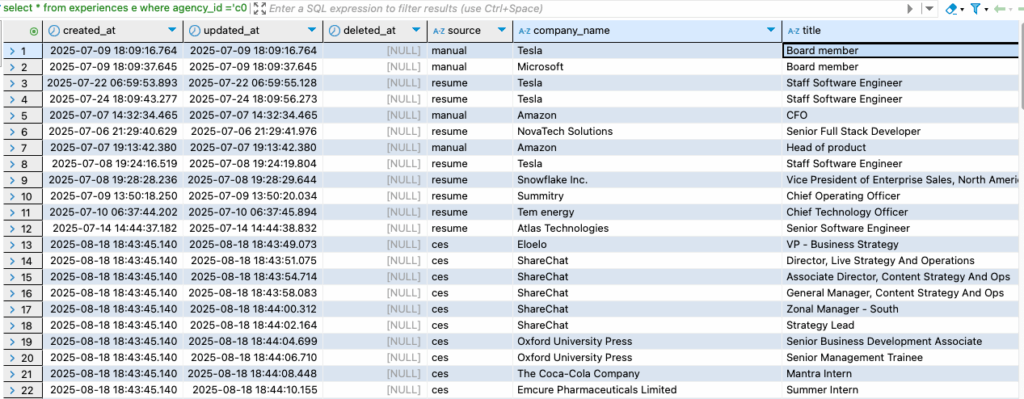
Step 3: Map and align fields with Atlas
Using our Migration Dashboard, we work with you to align your existing fields to the Atlas data model. You’ll review our suggested mappings and confirm or adjust as needed. Whether you’re dealing with standard fields or custom workflows, we make sure each item is accounted for and mapped correctly.
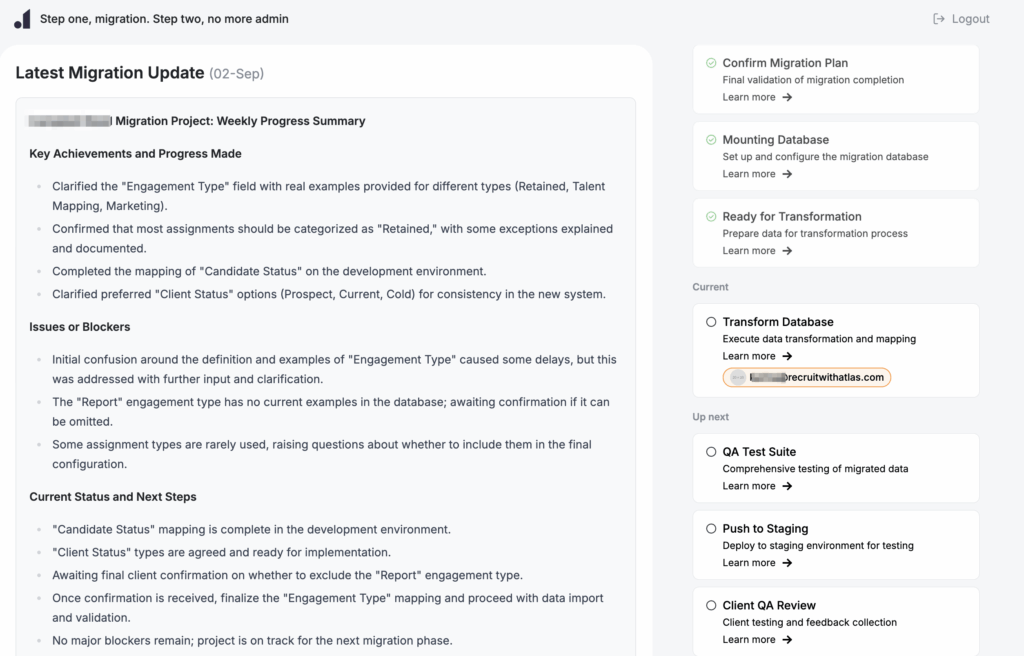
Step 4: Transform and standardize your records
We use DBT to run data transformations that clean, normalize, and prepare your records for Atlas. This includes removing duplicates, aligning formats, resolving inconsistencies, and applying defaults where needed. Every change is version-controlled and testable.
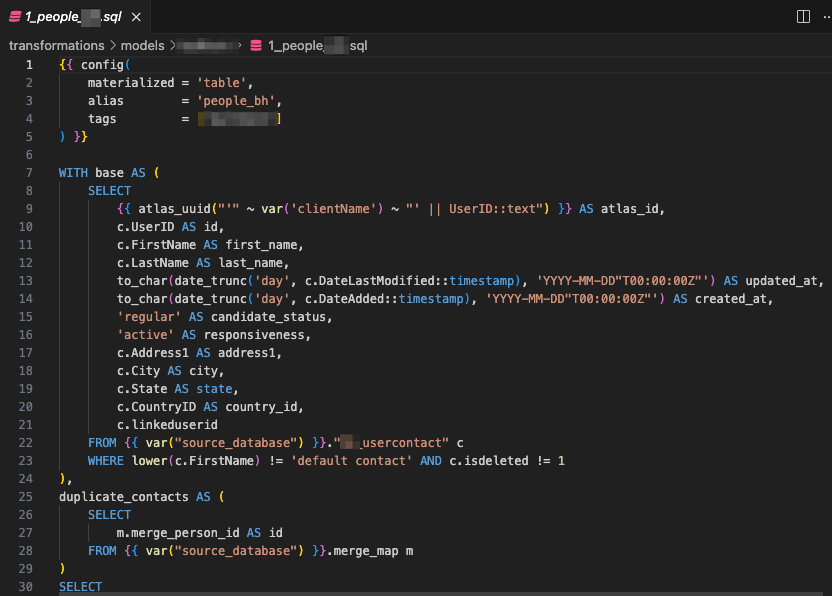
Step 5: Validate everything in a staging environment
We run automated QA tests to check data integrity, required field completion, and structural accuracy. After passing QA, your data is deployed into a staging version of Atlas. This is where your team can review and validate the records using a detailed checklist. You confirm that all information appears correctly and workflows are intact before giving the final go-ahead.
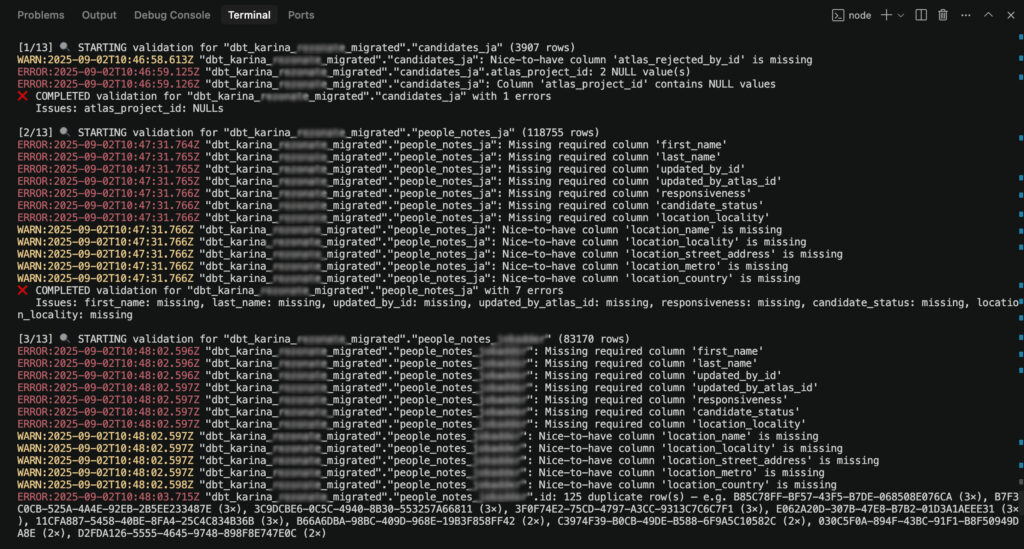
Step 6: Deploy to production and go live
Once staging is approved, we promote the data to your live Atlas environment. If you already use Atlas, new data is merged without disruption. If you’re starting fresh, the staging instance becomes your live platform. We complete full indexing, attach files, and confirm search functionality so your team can hit the ground running.
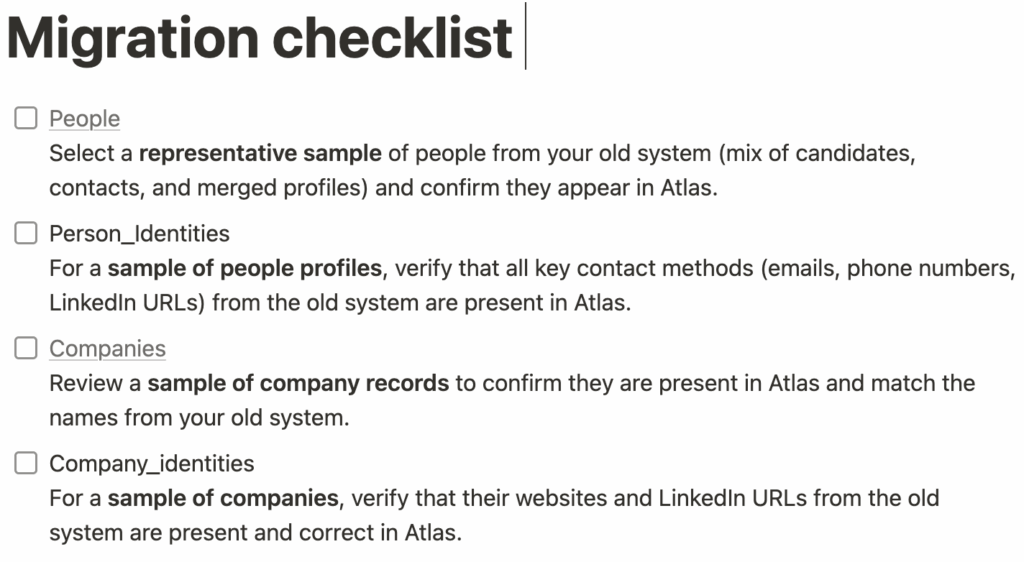
This six-step checklist ensures your migration is organized, accurate, and fully supported from start to finish.
Quick recap: Your ATS migration checklist
Use this summary to make sure all the key steps are covered:
☐ Audit your current ATS and define clear objectives for the move
☐ Clean your data, remove duplicates, and align inconsistent formats
☐ Decide which records to migrate and which to leave behind
☐ Confirm scope, timelines, and roles with your vendor
☐ Map each field from the old system to the new structure
☐ Test your data in staging and validate it thoroughly
☐ Prepare users before go-live and monitor closely afterward
☐ Run post-launch quality checks and gather team feedback
☐ Decommission your old system once you are confident in the new setup
You can use this checklist at each stage to stay on track and avoid surprises.
Frequently asked questions (FAQs) on ATS data migration planning for recruitment agencies
In many cases, yes. Some vendors support parallel running, where you continue using your old system while the new one is being set up. You’ll typically pause access during the final transfer to ensure data consistency.
That is very common. Most migration plans include a data clean-up phase before anything is moved. Focus on resolving duplicates, standardising fields, and removing anything irrelevant. Your new ATS is only as useful as the data it receives.
Not necessarily. Many agencies choose to migrate only active candidates, recent placements, and key client data. Archiving older or inactive records can speed up the process and keep the new system lean.
Ask your vendor about encryption, access controls, and GDPR compliance. A reputable provider should have a clear data security policy and should never retain your data beyond the project without explicit agreement.
A smooth migration to a new applicant tracking system (ATS) starts with a solid plan
Switching ATS platforms might feel daunting, but it doesn’t have to cause disruption. With a clear plan, clean data, and a structured checklist, you can make the move with confidence and start seeing the benefits of a faster, more effective ATS.
For agencies that would rather focus on hitting billing targets and improving candidate experience than managing file exports and field mapping, the right vendor makes a big difference. A provider that takes care of the technical heavy lifting allows you to avoid delays and move quickly into your new setup.
If you’re looking for a solution that keeps your workflows smooth and your team productive from day one with smart integration capabilities to boot, Atlas can help. You stay focused on recruitment while the platform handles the migration behind the scenes. Start here >>








